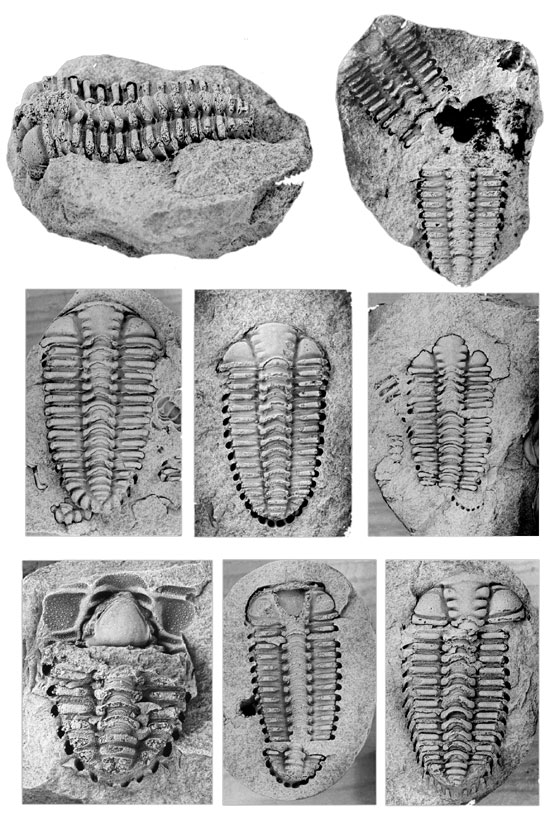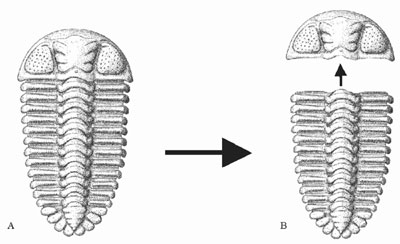
Exuviation of the Genus Placoparia Hawle and Corda, 1847 (Trilobita, Ordovician, Prague Basin, Czech Republic)
Jana Bruthansová1 and Petr budil2
1Palaeontological Department, National Museum, Václavské nám. 68, Praha 1, 115 79, Czech Republic. E–mail: jana.bruthansova@nm.cz
2 Czech Geological Survey, Klárov 3, Praha 1, 118 21, Czech Republic. E–mail: budil@cgu.cz
Key words: Exuviation. Placoparia. Trilobita. Ordovician. Prague Basin.
Introduction
The genus Placoparia Hawle and Corda, 1847 belongs to the most common Bohemian Ordovician trilobite genera. In the Prague Basin it ranges a wide stratigraphical scale from the Lower Ordovician Klabava Formation to the Middle Ordovician Letná Formation (for details see Prantl and Šnajdr, 1957, etc.). The aim of this paper is to evaluate possible modes of the exuviation process in this genus and distinguish the carcasses from the exuviae.
The genus Placoparia Hawle and Corda, 1847
As is noted above Placoparia belongs among the abundant Bohemian Ordovician trilobite taxa with world–wide occurrence.
For the purposes of this study, only two species of this genus Placoparia (Placoparia) cambriensis Hicks, 1875 and P. (P.) zippei (Boeck, 1828) were selected. These are represented in the museum collections by several hundreds of specimens and were very well available for this palaeoecological evaluation. In this paper the systematical classification as proposed Hammann (1971, 1974) is followed. P. (P.) cambriensis occurs in the Ordovician of the Prague Basin from the Klabava Formation (Arenig) to the Šárka Formation (Llanvirn), the second taxon P. (P.) zippei is known only from the Dobrotivá Formation (Llanvirn).
supposed mode of life and the determination of carcasses
Some authors, for example Pribyl and Vanek (1976), Havlícek and Vanek (1990) a. o. considered Placoparia as trilobites which had lived semi–burried in the soft sediment. Placoparia trilobites likewise possessed the natant type of hypostome and according to Fortey and Owens (1999) these trilobites were adapted to the particle feeding strategy. In this paper is shared these views that Placoparia trilobites were nektobenthic, able to bury in the sediment and using the particle feeding.

Figure 1. All specimens deposited in the collections of the National Museum, Prague. A–E, G. Placoparia (P.) zippei, Dobrotivá Formation, Bohemia. A. S–shaped specimen NML 34136, Malé Prílepy, x 2. B. Thoracopygon NML 34109, Malé Prílepy, x 2,6. C. Complete specimen NML 34098, Malé Prílepy, x 1,3. D. Complete specimen NML 34153, Malé Prílepy, x 1,8. E. Cephalothorax NML 34141, Malé Prílepy, x 1,6. G. Specimen with hypostoma in situ and isolated pygidium NML 34144, Malé Prílepy, x 1,7. F, H. P. (P). cambriensis, Šárka Formation, Bohemia. F. Specimen in Salterian position with hypostoma in situ NML 33455, Praha–Šárka, x 2,8. H. Specimen with isolated cephalon NML 34127, Praha–Šárka, x 1,1.
The most common preservation pattern of complete Placoparia represent exoskeletons with straight thorax or slightly S–shaped, with the most abundantly the 2–4th thoracic segment convexly and cephalon slightly ventrally bent (Figure 1A). Such trilobites show (with several exceptions only) no marks of disarticulation and possess the hypostoma in situ.. With the agreement of above mentioned live strategies these specimens are supposed as the carcasses.
In the studied material, a great amount of specimens of P. (P.) cambriensis are completely or incompletely enrolled. According to Romano (1976), Clarkson and Henry (1973) and Henry (1985) trilobite enrolment may represent a defensive response to stressfull biotic or abiotic conditions. Also the enrolled (complete or incomplete) trilobites are supposed to be carcasses.
Exuviae
The exuviation of some Placoparia were described by Romano (1976) as the process of shedding free cheeks and subsequent disarticulation of exoskeleton. Such palaeoecological studies have never been investigated on the Bohemian material except one specimen in Bruthansová (2003).
According to our observations in the Bohemian Placoparia (P.) cambriensis and P. (P.) zippei, in the most cases during the exuviation had opened especially the sutures between cephala and rest of the body (see Figures 1, 2). As the results of this relatively simple process we consider especially the thoracopygons and separated cephala without inversion. Thoracopygons could be later more or less disarticulated, at least in some cases probably during and/or because of the ecdysial procedure.

Figure 2. Modes of exuviation in Placoparia (P.) zippei.. A. complete specimen. B. specimen with isolated cephalon.
One specimen was found in the position typical for the Salterian mode of exuviation (Figure 1F) and two specimens with inverted pygidia and one with cephalon. These two configurations are rather the exceptions than the rules of exuviation as noted McNamara (1986).
Acknowledgements
This study was realised with the financial support of the Grant Agency of the Academy of Sciences of the Czech Republic project Nş B 3407201. The part of J. Bruthansová was also prepared with support of the Grant Agency of the Czech Republic, project Nş 205/02/0934. Many thanks are due to Ivan Kolebaba who drew the figure 2.
References
Bruthansová, J. 2003. Exuviation of selected Bohemian Ordovician trilobites. Special Papers in Palaeontology.. (in press)
Clarkson, E. N. K. and Henry, J. L. 1973. Structures coadaptives et enroulement chez quelques Trilobites ordoviciens et siluriens. Lethaia, 6: 105–132.
Fortey, R. A. and Owens, R. M. 1999. Feeding habits in trilobites. Palaeontology, 42(3): 429–465.
Hammann, W. 1971. Die Placopariinae (Trilobita, Cheirurina; Ordovizium). Seckenbergiana lethaea, 52(1): 53–75.
Hammann, W. 1974. Phacopina und Cheirurina (Trilobita) aus dem Ordovizium von Spanien. Senckenbergiana lethaea, 55(1–5): 1–151.
Havlícek, V. and Vanek, J. 1990. Ordovician invertebrate communities in black–shale lithofacies (Prague Basin, Czechoslovakia). Vestník Ústredního ústavu geologického, 65(4):223–236.
Henry, J. L. 1985. New information on the coadaptive devices in the Ordovician trilobites Placoparia and Crozonaspis, and its significance for their classification and phylogeny. Transactions of the Royal Society of Edinburgh, 79: 319–324.
McNamara, K. J. 1986. Techniques of exuviation in Australian species of the Cambrian trilobite Redlichia. Alcheringa, 10: 403–412.
Prantl, F. and Šnajdr M. 1957. Studie o rodu Placoparia Hawle a Corda (Trilobitae). Sborník Ústredního ústavu geologického, oddíl paleontologický, 23 (1956): 497–521.
Pribyl, A. and Vanek, J. 1976. Palaeoecology of Berounian trilobites from the Barrandian area (Bohemia, Czechoslovakia). Rozpravy Ceskoslovenské akademie ved, Rada matematických a prírodních ved, 86(5): 1–40.
Romano, M. 1976. The trilobite genus Placoparia from the Ordovician of the Valongo area, North Portugal. Geological Magazine, 113: 11–28.
Received: February 15, 2003
Accepted: June 15, 2003